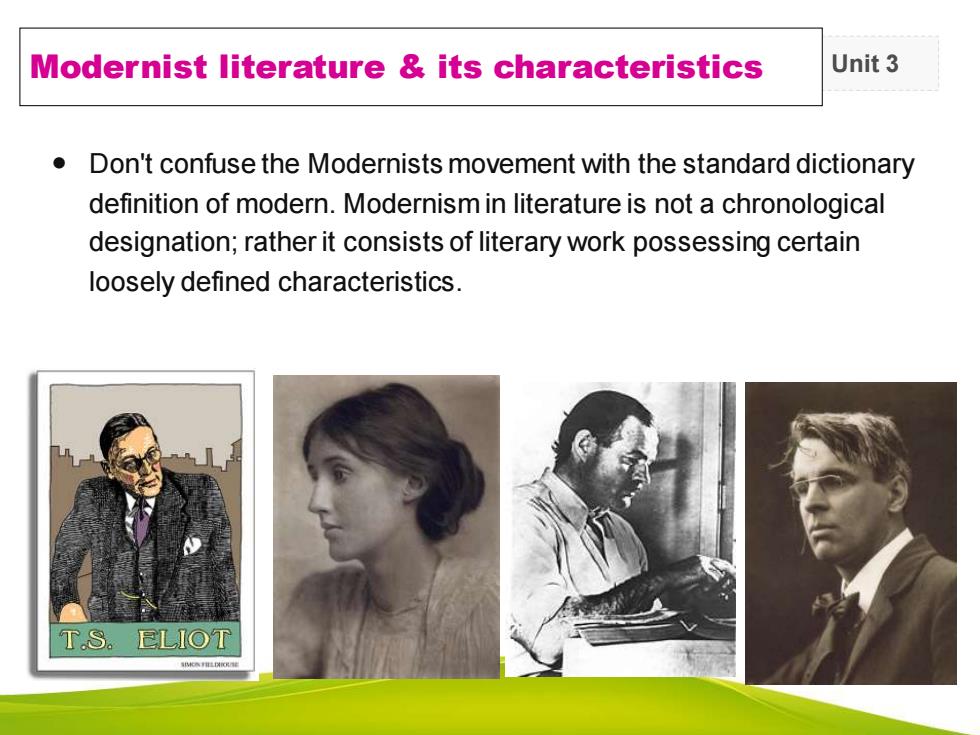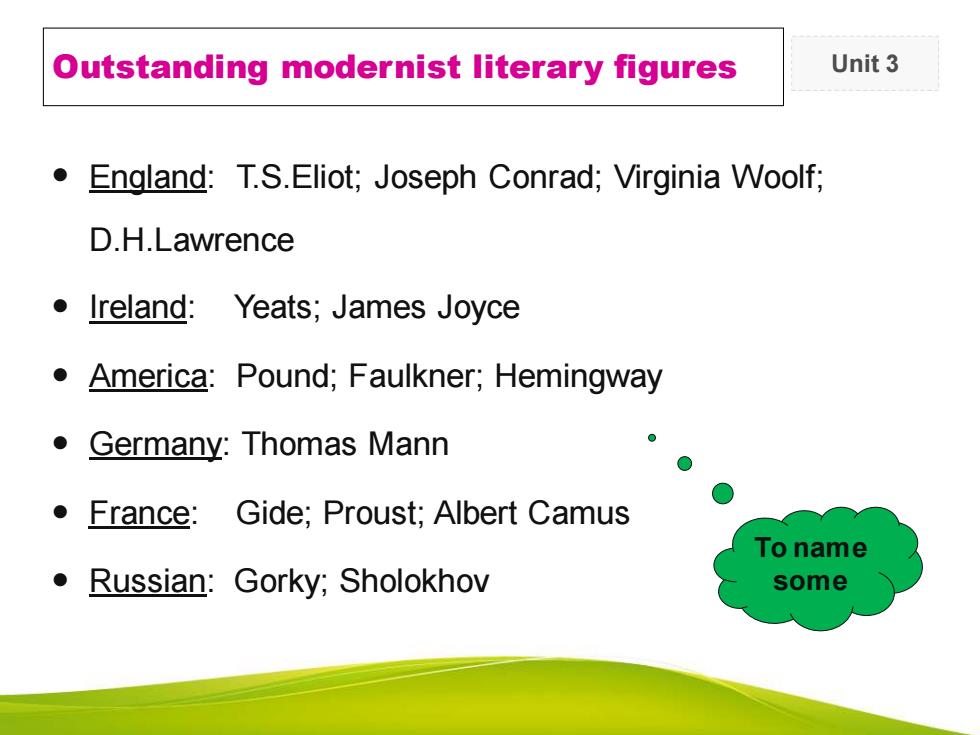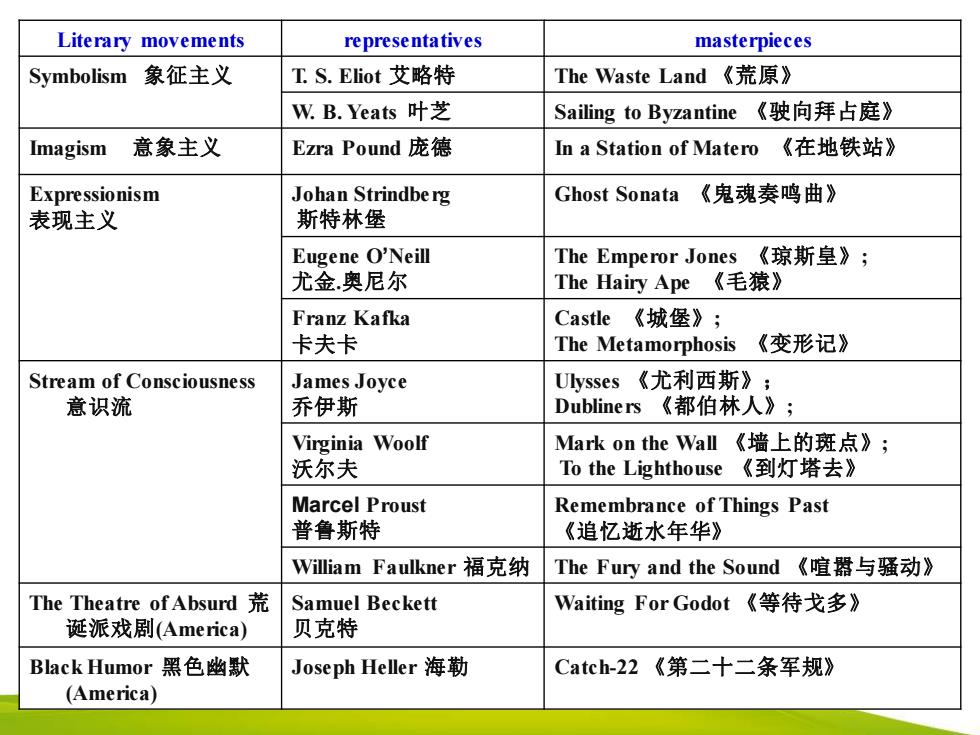
Unit3Modernistliterature &its characteristicsDon't confuse the Modernists movement with the standard dictionarydefinitionof modern.Modernisminliteratureis notachronologicaldesignation;ratherit consistsof literarywork possessingcertainlooselydefinedcharacteristicsELIOTT.S.IIMCTILIAI
Modernist literature & its characteristics Unit 3 ⚫ Don't confuse the Modernists movement with the standard dictionary definition of modern. Modernism in literature is not a chronological designation; rather it consists of literary work possessing certain loosely defined characteristics

Unit3Some characteristics of modernist literature1.James Joyce (from Dublin,Ireland)- His most experimental andfamous work, Ulysses, completely abandons generally acceptednotions of plot,setting,and characters.2. Major works of modernist fiction, following Joyce's Ulysses, break upnarrative continuity, depart from standard ways of representingcharacters,and violate traditional narration with"stream ofconsciousness"andotherinnovations.For example, the novel Ulysses has one chapter of script (like a play)another without any punctuation at all.3. To sum up:symbolic images;fragmentedplot;trivialsubjectspsychological insight-internalmonologues,"stream of consciousness
Unit 3 Warming up 1. James Joyce (from Dublin, Ireland) - His most experimental and famous work, Ulysses, completely abandons generally accepted notions of plot, setting, and characters. 2. Major works of modernist fiction, following Joyce’s Ulysses, break up narrative continuity, depart from standard ways of representing characters, and violate traditional narration with “stream of consciousness” and other innovations. For example, the novel Ulysses has one chapter of script (like a play), another without any punctuation at all. 3. To sum up: symbolic images; fragmented plot; trivial subjects psychological insight—internal monologues, “stream of consciousness” Some characteristics of modernist literature

Unit3Outstanding modernist literary figuresEngland: T.S.Eliot; Joseph Conrad: Virginia WoolfD.H.LawrenceIreland:Yeats;JamesJoyceAmerica: Pound; Faulkner; HemingwayGermany:ThomasMannFrance:Gide; Proust; Albert CamusTonameRussian: Gorky; Sholokhovsome
Outstanding modernist literary figures Unit 3 ⚫ England: T.S.Eliot; Joseph Conrad; Virginia Woolf; D.H.Lawrence ⚫ Ireland: Yeats; James Joyce ⚫ America: Pound; Faulkner; Hemingway ⚫ Germany: Thomas Mann ⚫ France: Gide; Proust; Albert Camus ⚫ Russian: Gorky; Sholokhov To name some

Literary movementsrepresentativesmasterpiecesSymbolism象征主义T.S.Eliot艾略特TheWasteLand《荒原》W.B.Yeats叶芝SailingtoByzantine《驶向拜占庭》意象主义EzraPound庞德《在地铁站》ImagismInaStation ofMatero《鬼魂奏鸣曲》ExpressionismJohan StrindbergGhost Sonata表现主义斯特林堡Eugene O'NeillTheEmperorJones《琼斯皇》;尤金.奥尼尔TheHairyApe《毛猿》Franz KafkaCastle《城堡》;卡夫卡《变形记》The MetamorphosisJames JoyceUlysses《尤利西斯》;Stream of Consciousness意识流乔伊斯Dubliners《都伯林人》:Virginia WoolfMarkontheWall《墙上的斑点》;沃尔夫To the Lighthouse《到灯塔去》MarcelProustRemembrance ofThings Past普鲁斯特《追忆逝水年华》William Faulkner福克纳The Fury and the Sound《喧与动》The Theatre ofAbsurd荒Samuel BeckettWaitingForGodot《等待戈多》贝克特诞派戏剧(America)BlackHumor黑色幽默JosephHeller海勒Catch-22《第二十二条军规》(America)
Unit 3 Literary movements representatives masterpieces Symbolism 象征主义 T. S. Eliot 艾略特 The Waste Land 《荒原》 W. B. Yeats 叶芝 Sailing to Byzantine 《驶向拜占庭》 Imagism 意象主义 Ezra Pound 庞德 In a Station of Matero 《在地铁站》 Expressionism 表现主义 Johan Strindberg 斯特林堡 Ghost Sonata 《鬼魂奏鸣曲》 Eugene O’Neill 尤金.奥尼尔 The Emperor Jones 《琼斯皇》; The Hairy Ape 《毛猿》 Franz Kafka 卡夫卡 Castle 《城堡》; The Metamorphosis 《变形记》 Stream of Consciousness 意识流 James Joyce 乔伊斯 Ulysses 《尤利西斯》; Dubliners 《都伯林人》; Virginia Woolf 沃尔夫 Mark on the Wall 《墙上的斑点》; To the Lighthouse 《到灯塔去》 Marcel Proust 普鲁斯特 Remembrance of Things Past 《追忆逝水年华》 William Faulkner 福克纳 The Fury and the Sound 《喧嚣与骚动》 The Theatre of Absurd 荒 诞派戏剧(America) Samuel Beckett 贝克特 Waiting For Godot 《等待戈多》 Black Humor 黑色幽默 (America) Joseph Heller 海勒 Catch-22 《第二十二条军规》

Stream of ConsciousnessUnit3Inliterarycriticism,streamofconsciousness,alsoknownasinteriormonologue,isanarrativemodeor devicethatdepictsthemultitudinous thoughts and feelings which pass through themind.ThetermwascoinedbyWilliamJamesin1890inhisThePrinciplesofPsycholoay,andin1918MaySinclairfirstappliedthetermstreamofconsciousness,inaliterarycontext,whendiscussingDorothyRichardson'snovels.Streamof consciousnessis anarrativedevicethatattemptstogivethe written equivalent of the character'sthought processes,eitherin alooseinteriormonologue(seebelow),orinconnectiontohisorheractions
Stream of Consciousness Unit 3 ⚫ In literary criticism, stream of consciousness, also known as interior monologue, is a narrative mode or device that depicts the multitudinous thoughts and feelings which pass through the mind. ⚫ The term was coined by William James in 1890 in his The Principles of Psychology, and in 1918 May Sinclair first applied the term stream of consciousness, in a literary context, when discussing Dorothy Richardson's novels. ⚫ Stream of consciousness is a narrative device that attempts to give the written equivalent of the character's thought processes, either in a loose interior monologue (see below), or in connection to his or her actions